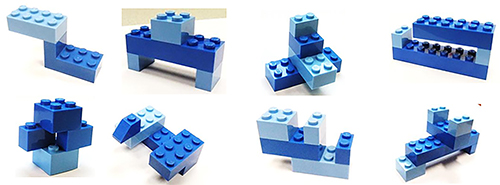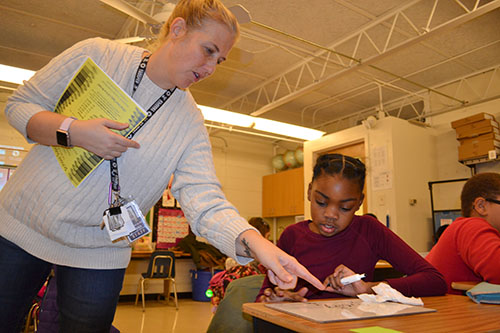Christine Shenouda Studies Impact of Gender Stereotype Threat on Girls' Performance and Interest in Math

Christine Shenouda, Psychology Department Teaching Assistant Professor
January 22, 2018
“I’m a girl, so I’m not very good at math.”
This gender stereotype is a common misconception that's pervasive in today's society. According to Christine Shenouda, in her Ph.D. dissertation entitled, Effects of Gender Stereotypes on Children’s Beliefs, Interests, and Performance in STEM Fields, this gender stereotype can have a devastating effect on girls when they’re reminded of it just before taking a math test. This is called gender stereotype threat. But while this stereotype—girls aren’t good at math—isn’t true, girls who have always done well in math—even those whose favorite subject is math—can still fall prey to its insidious influence.
What are some common gender stereotypes? Shenouda says our society has lots. Girls wear makeup, paint their nails, and have long hair. Boys don’t. Boys like all sports; girls don’t. Girls play with dolls; boys don't. But one of the most sinister stereotypes out there is this: boys are good at math; girls aren’t.
Surprisingly, research has shown that children begin inculcating gender sterotypes at an alarmingly early age. According to Shenouda, by one and a half to two years, “Certain behaviors are associated with men and women.” For instance, kids are surprised to see a man putting on makeup or doing stuff in the kitchen.
One of the first things Shenouda addressed in her research was this question: How do gender stereotypes affect children’s beliefs? “Do kids think that, if you are a man, you automatically know to do things and know not to do other things? Or if you’re a woman, same thing.”

Stereotypical puppets: A male mechanic and a female nurse
To discover the answer, she did a fun study with 3–5 year olds using two puppets, a nurse and a mechanic. For the first group of kids, the puppets were consistent with stereotypes: the woman was a nurse, the man was a mechanic. In addition to wearing the appropriate outfits, the gender of each was clearly defined. For instance, the mechanic puppet was wearing a mechanics outfit and was clearly male; he had short hair, a moustache.
First Shenouda asked job-related questions, like, “Who would know more about how to fix a flat tire?” and “who would know more about how to take your temperature?” However, she also asked about other areas not associated with the job, such as interests or pastimes. Some questions were about neutral activities, like watching TV; others were about activities typically stereotyped as more for men or for women: sports, arts and crafts, etc.

Atypical puppets in regards to stereotypes: A female mechanic and a male nurse
The second group of kids was shown different puppets—atypical versions when it comes to stereotypical male-female roles: a male nurse and a female mechanic. Shenouda reports receiving quite interesting responses when the roles were flipped. While youngsters associated professional expertise to the right character (the male nurse would still know more about the human body than the female mechanic), “Somehow they made the connection in their mind that, ‘If you are a man, but you want to be a nurse, then you can’t like football!’” she shares. “So if you’re doing a profession for women, then you’re also more likely to not be interested in typical male things outside of the profession.”
In addition to children’s beliefs, she also sought to find out how gender stereotypes influence interests and performance. In other words, “What are the kids interested in and, also, how do they perform on tests, as affected by gender stereotypes?”
The performance area is where stereotype threat comes in. A huge buzzword right now in the literature, it has consistently been found to negatively impact girls’ scores during testing. Shenouda explains how the phenomenon works:
“When you belong to a certain group (say your gender is female, or you’re an African American, or any type of group), she says, “and that group is stereotyped as being not as good at whatever it is (such as gender in math), if you’re somehow reminded of that stereotype, then you’re going to perform worse on a test than if you’re not reminded of it.”
Shenouda shares a scenario that illustrates how stereotype threat works (Spencer et al., 1999). Suppose a group of female students, say math majors (ostensibly pretty good at math), was recruited and divided into two groups, with one group being told, “Men do better on this test than women do,” but the other group either being told "this test doesn't show any gender differences" or that, “Women do better than men do.” According to Shenouda, “The results when you say something positive are not as strong as when you remind them of that negative attribute, because they’ve been reinforced to believe the negative one all the time.”
“It’s scary, in a way, right?” Shenouda observes. And it also sounds rather like Pavlovian conditioning.
She adds that this subtle brainwashing is also true of other stereotyped groups…such as African-Americans who are often stereotyped as not being as intelligent in general as other races.

Two fourth graders ready to share their answer.
Regarding the impact combined gender and racial stereotypes can have, Shenouda shares another study—one about Asian girls in K-8th grades—that got her attention (Ambady et al., 2001). Dealing with two conflicting stereotypes about themselves, these girls were faced with a real dilemma: “Asians are stereotyped as being good at math,” Shenouda acknowledges, “but then girls are stereotyped as not being good at math. So there’s this conflict!”
In this study, researchers randomly assigned girls into three different groups who, before doing a math test, were subtly reminded of a stereotype. Researchers gave the subjects one of three different pictures to color, not telling them that coloring the picture was part of the test; they just said, “Here’s something to color while I set some things up.”
For one group, the researchers activated their gender identity by giving them a picture of a girl holding a doll. Researchers activated the ethnic identity of subjects in the second group by giving them a picture of Asian kids playing with chopsticks. The third, the control group, they gave a picture of trees, which activated no stereotype at all.
What were the results of the study? Girls whose gender identity was activated did the worst; girls reminded of their ethnic identity did the best; girls in the control group (given the picture of a tree) scored in between.
While some might argue that laboratory testing is very artificial, “When you think about the kinds of messages that girls are exposed to every day, it kind of becomes this priming effect, or this gender activation effect, over and over again,” Shenouda shares. “Some studies, including my dissertation, argue for continuous threat. So there’s always that continuous stereotype threat; you’re continuously reminded that, ‘You are a girl; you’re not good at math,’ therefore you aren’t doing as well.’”
Shenouda also wanted to see if stereotype threat affects ages even earlier than first grade. Since preschoolers don’t do math yet, she had them play with Legos or construction toys, which are great for spatial skills. (Spatial skills are associated with better math and science skills, and there are consistently significant differences between men and women on spatial skills: men are better than women across the board, possibly as a result of practice.)
Shenouda admits that there may be an innate gender difference regarding spatial skills because studies done with 3-months-olds have shown a slight difference. But while there might be a slight difference starting out, Shenouda believes we exaggerate it by the kind of toys we give youngsters.

Lego designs Shenouda had 4-year-old girls assemble as part of her study.
So she did a study with 4-year-old girls, giving them pictures of either a girl holding a doll or trees to color. Then she had them assemble a specific Lego design and would time them. The girls who colored the girl with the doll were slower than the girls who colored the trees.
For grades K–3, the coloring didn’t have an effect, but overall the girls were slower than the boys. “I think that there is this continuous threat, so girls see blocks and automatically think, ‘This is not for me. This is not an activity for me.’”
So we’ve learned that this insidious seed—the notion that girls aren’t good at math—gets planted and starts to grow at an early age. But how does it get planted, and who does the sowing?
Shenouda claims toys are one of the culprits and that toy manufacturers are partly to blame, in that their perception of who their market is and the types of challenges boys can overcome in comparison to girls have been shaped by—you guessed it—gender stereotypes. Think about the images plastered all over construction toys’ boxes—they’re mostly pictures of boys, not girls.

A fourth grader works at solving a problem.
Shenouda also takes issue with the color pink—especially when it comes to pink (girls’) Legos. “It’s a marketing strategy,” she complains, “because they want to sell more! Because if you have a boy and a girl, and you buy just one set, then they’re not making as much profit as if you buy the pink set for the girl and the all-color set for the boy.”
Family budget issues aside, her bias against pink Legos is not unfounded. She originally used primary-colored Legos for certain tasks during her dissertation research, but then wanted to switch to pink to “see if the girls, once they see pink, feel like, ‘This is for me; I can do this!’ But I couldn’t find all the parts in pink and purple Legos,” she grumbles. “And I looked at the sets, and they all seemed much simpler than the ones that are more blackish-blueish, presumably for boys.” In other words, toy designers had said, “This is for girls; we shouldn’t make it quite so challenging. They probably can’t get this, so we’ll make it less complicated!” which just compounds the gender stereotype issues for girls.
In addition to toys, Shenouda believes another possible source is children’s books. In order to make books something kids can relate to, children’s authors tend to put the book’s protagonist into the middle of a dilemma based on stereotypes depicting middle school as terrible: “But I feel like they plant the seed in kids’ minds that this is what things should look like or what to expect,” Shenouda explains.
But although toys might play somewhat of a role, Shenouda claims the two biggest suspects are teachers, and especially parents. “There are studies showing that kids’ perception of and self- confidence in math is more affected by their parents’ expectations than it is by their own performance,” she asserts.
In regards to the stuff teachers and parents do to foster the “girls-are-bad-at-math stereotype, “It’s really subtle. It’s not intentional; they don’t specifically say, “You’re a girl; you can’t do this,” Shenouda says. But she shares some scenarios illustrating how it might happen. Perhaps a girl is doing well, but senses that her parents believe her brother is going to do a better job on math than she does. So her parents encourage her brother when he gets a good grade in math, or when he’s struggling, tell him, “You can do this problem; I know you can do it!” However, they tell her, “It’s ok; you like history as well,” when she doesn’t do as well in math.

Two fourth graders work together to complete their worksheet.
Teachers are guilty too. Perhaps when a girl raises her hand in class but gets it wrong, the teacher says, “That’s ok. That’s ok,” but if it happens to a boy, the teacher will say “Try harder! I know you can do this!”
How else do parents and teachers contribute? “You’re so smart!” is a phrase teachers, parents, and even grandparents (mea culpa!) use to praise or affirm children. Shenouda says that, according to research, it’s a no-no. She goes on to explain about a fixed mindset vs. a growth mindset.
In these non-gender-specific concepts, someone with a fixed mindset believes, “I only have certain abilities and can do certain things.” However, a growth mindset says, “The harder I work, the better I’m going to get.”
Shenouda exhorts us to encourage children using a growth mindset type of praise: “Wow, you did a good job; you worked so hard!” Fixed mindset praise is telling kids “Wow, you’re so smart!” She elaborates on the drawbacks of the fixed mindset:
“If you think you’re smart, that’s great. But then there’s a limit. You’re going to think that there’s something you aren’t smart enough for… It’s counter intuitive,” she says, “because we want kids to know that they’re smart. But they know that smartness isn’t something you could necessarily change. But they know that hard work all depends on what you put into it.”
She describes a study based on these concepts from Carol Dweck's research group at Stanford. Children were given an easy puzzle and after completing it, were told either, “You’re smart!” or “You worked hard!” Then they were given a harder puzzle, and those who had been praised for hard work persisted longer on a challenging task than those who were told they were smart, whose mindset was: “Maybe I’m smart, but I’m not smart enough for this,” whereas the growth mindset group had thought, “If I work harder, maybe I’ll get it.”
Girls’ self-confidence as they mature is another issue. For instance, around 4th grade, girls start to become less self-confident, which has a bearing on how this article actually came about.
(In an aside, I [the writer] had already encountered this 4th-grade phenomenon. My granddaughter, Ella, who had previously loved math, excelled in it, and wanted to be a math teacher, hit fourth grade, and all of a sudden, had started saying things like, “Math is hard; I can’t do this.” Upon mentioning this to Christine Shenouda, her rejoinder had been that she too had encountered similar, self-confidence issues with her 4th-grade daughter. Thus, after briefly mounting her gender-stereotype-threat soap box and imparting enough of her wealth of wisdom regarding the subject to pique my curiosity, the seed for this article was sown.)
Regarding self-confidence, Shenouda says girls typically have more issues with it than boys do, especially prior to and during the teenage years, when they become more aware of things like body image and how they look. This lack of self-confidence can affect areas they had previously felt they were good at. While it doesn’t usually effect their performance yet, it does effect their self-confidence.

Above and Below: Ms. Alves teaches math to her students.

Who/what else might help to foster gender stereotypes? Schools and, obliquely, teacher education programs, may also unwittingly be playing a role. For instance, teachers in younger grades are predominately female; however, math and science, or the more difficult math and science sections in middle school and high school are predominately taught by men, which sends a subliminal message about females’ ability in math.
A teacher’s self-confidence could also play a role. Since the majority of teachers in early grades are female, if she has insecurities about her math performance, that will trickle down to her female students. (If it were an insecure male teacher, it would probably trickle down to the boys, but most early teachers are female.)
While Shenouda assigns some blame to teachers, she acknowledges that her field is also somewhat responsible. “Researchers do not do a great job at sharing all they know with teachers,” she admits. “There’s this gap of, ‘We know all of this about teachers!’ but then the teachers don’t know.” So teachers miss out on much of the information researchers uncover.
What can be done to enlighten teachers regarding gender stereotypes they’re propagating? For one, the teachers who teach the teachers (teacher preparation programs) should be made aware.
“In an ideal world, we would want teachers to be taught about that sort of thing,” she says. For instance, teachers are already being taught about growth and fixed mindset. But Shenouda acknowledges that there are some barriers that need to be broken down: “Some teachers believe that boys are born to do certain things and girls are born to do certain things. So challenging that is pretty hard.”
Shenouda’s advice for teachers is this: “Encourage boys and girls to participate equally in activities. And don’t let your own biases get in the way of how you treat boys and girls. Because it does affect their behavior, interest, and performance. It has a huge impact on them.”
Another piece of advice for teachers, including pre-school teachers? “Be mindful of what kind of messages you are sending to boys and girls…What teachers do early on affects girls and boys and can have a long-term effect,” she warns.

A fourth grader eagerly showcases her answer.
Regarding pre-school teachers’ long-term influence, Shenouda shares about a day-care study with 1½-year-old kids. Teachers responded to girls more when they were speaking softly, but didn’t respond to boys until they were angry, whining, or crying, which, of course, encouraged the boys to behave more aggressively than the girls. In this longitudinal study, a year later, the boys were more aggressive and the girls were more gentle when asking, because the teachers hadn’t been responding until the boys became aggressive.
In a similar vein, Shenouda alludes to another dangerous trend: schools that separate girls and boys due to the belief that they learn differently and hear differently—that girls need to be spoken to softly and boys need to be shouted at.
Ironically, the folks promoting these trends, that Shenouda emphasizes, without theoretical basis are much more able to reach people than researchers with real research. “Partly because we have been socialized all our lives to think that men and women are different,” Shenouda explains, “so it’s easier for us to accept this kind of notion that they are indeed different. It’s better to prove that theory as opposed to just saying, ‘You know what, everything you’ve believed since you were a young kid is wrong.”
Does Shenouda have any advice for parents to help prevent or to counteract stereotypes that happen in preschool and on up? Be a role model, for one. “If you want your kids to do certain things, then you should be modeling that. If we’re dealing with a two-parent family, try to split the work evenly in the house, don’t make comments about what men and women should and shouldn’t do.”
She also cautions parents: “Don’t automatically assume that if your son or daughter does something specific, that it’s because of their gender. For example, if a boy is doing something that happens to be masculine, don’t be like ‘Oh, it’s because he’s a boy.’” She claims that parents often make assumptions regarding what their child can do based on their gender, which she calls a feedback loop that sets certain expectations for their kids.

A fourth grader in the midst of the problem set.
She also encourages parents to provide their kids with a variety of resources, regardless of gender. “Let girls play with Legos, or boys nurture dolls. Boys need to learn how to nurture, too. Try to encourage girls to get out of their comfort zone and do things like science and engineering. There are so many opportunities for girls, and I’ve actually had parents complain that there aren’t as many opportunities for boys as girls.”
In the face of such dismal prospects regarding girls and math, Shenouda says there’s good news. “There are no differences between boys and girls in school performance in math and science, at least until high school, where differences show up on standardized test performances, such as ACT and SAT” (which she claims is another issue altogether).
But here’s the bad news. Shenouda says gender stereotype threat does play a key role in terms of her other focus: girls’ interest in math.
“Where there is a difference is in the interest part,” she admits, “so the girls do not identify with science and math fields as much as boys do.” Even among boys and girls who perform equally well on math, “The girls do not identify with math fields as much as boys do,” she adds. “They don’t feel like it’s a field for them.” Which means that despite society’s need for more workers in STEM fields, girls are less likely to choose careers in those fields.
While Shenouda has painted a somewhat bleak picture regarding how gender stereotypes impact the number of women in STEM, Shenouda says we should take heart.
“There has been a lot of progress, we shouldn’t ignore that. If we think about STEM fields 50 years ago with women, it’s a completely different world. We know so much more now, and that knowledge shouldn’t discourage us, it should empower us. But now we know, and we need to keep moving forward. We are doing a great job, so I think we should be optimistic that things are only going to get better.
Story and photographs by Elizabeth Innes, Communications Specialist, I-STEM Education Initiative.
More: Faculty Feature, Underserved Students/Minorities in STEM, Women in STEM, 2018
For more articles about gender stereotypes and gender stereotype threat, see:
- Does a Male Nurse Know About Football?: American and Egyptian Children’s Understanding of Gender and Expertise
- Effects of Gender Stereotypes and Stereotype Threat on Children’s Performance on a Spatial Task
- “Double Bind” Study Examines Obstacles Women of Color Face in Engineering

A fourth grader works through her math worksheet.













.jpg)
















